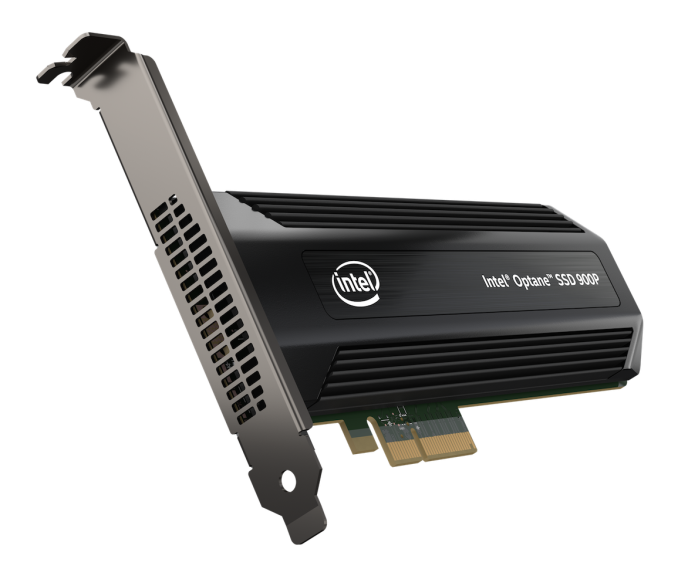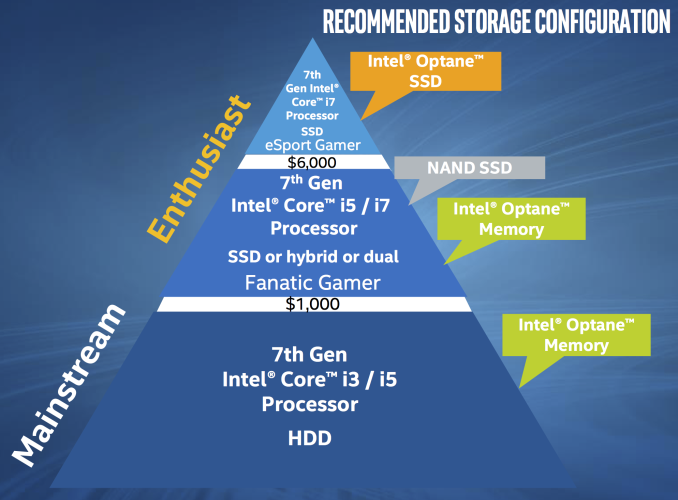The Intel Optane SSD 900P 280GB Review
by Billy Tallis on October 27, 2017 9:30 AM EST
Whenever Intel develops a new generation of SSDs based entirely on in-house technology, the result is usually a product that turns heads. Several times, Intel has set a new standard for SSD performance, starting with its original X25-M. Their most recent shake-up of the consumer SSD market was the Intel SSD 750, the first consumer NVMe SSD. Such significant releases don't happen every year, and in the intervening years Intel's competitors always catch up and surpass Intel.
However this year's revolution from Intel will be very hard for the competition to match anytime soon. All of Intel's previous record-setting SSDs have relied on the drive's controller to stand out from the crowd. This time, Intel's advantage comes from the storage medium: its 3D XPoint memory technology, a new nonvolatile memory that offers much higher performance than flash memory.
The Intel Optane SSD 900P
The new Intel Optane SSD 900P is a premium NVMe PCIe SSD offering the highest level of performance, with a moderate capacity. The Optane SSD 900P is intended for high-end desktop systems and workstations with very disk-heavy workloads. The Optane SSD 900P isn't for everyone and won't be displacing any existing products - it exists alone in a new product tier, with prices that are more than twice what the fastest flash memory based SSDs are selling for.
Optane is Intel's brand name for products featuring 3D XPoint memory. The Intel Optane SSD 900P is actually the third Optane product to be released, but it's the first family member to go after the high end consumer market segment. The Intel Optane Memory M.2 drives released earlier this year have capacities far too small for general-purpose storage use and instead have been marketed for use as a cache device to be paired with a mechanical hard drive. Intel's caching strategy works and can bring a hard drive's responsiveness up to the level of mainstream SSDs, but it has downsides. The Optane Memory caching requires a few extra steps to setup, and the caching software will only run on Intel platforms introduced this year: Kaby Lake or newer.
The Optane SSD DC P4800X is Intel's flagship enterprise SSD, and it is priced accordingly—putting it far out of reach of consumer budgets, and even with a price tag of over $1500 for 375GB it has been quite difficult to acquire. In the enterprise storage market, the P4800X has been highly sought after, but it isn't appropriate for all use cases and is not a threat to the many enterprise SSDs that prioritize capacity over performance and endurance.
The Optane SSD 900P will still cause some sticker shock for consumers expecting prices in line with M.2 PCIe SSDs, but it is acceptable for the kinds of machines that might be packing multiple GPUs or 10+ CPU cores. The Optane SSD 900P probably wouldn't be the only drive in such a system, but it would work well as a blazing fast primary storage device.
| Intel Optane SSD 900P Specifications | ||
| Capacity | 280 GB | 480 GB |
| Controller | Intel SLL3D | |
| Memory | Intel 128Gb 3D XPoint | |
| Interface | PCIe 3.0 x4 | |
| Form Factor | HHHL Add-in card or 2.5" 15mm U.2 |
HHHL Add-in card |
| Sequential Read | 2500 MB/s | |
| Sequential Write | 2000 MB/s | |
| Random Read IOPS | 550k | |
| Random Write IOPS | 500k | |
| Power Consumption | 8W Read 13W Write 14W Burst 5W Idle |
|
| Write Endurance | 10 DWPD | |
| Warranty | 5 years | |
| Recommended Price | $389 ($1.39/GB) | $599 ($1.25/GB) |
The Intel Optane SSD 900P is initially launching with 280GB and 480GB capacities. Both sizes will be available as PCIe 3.0 x4 half-height half-length add-in cards, and the 280GB model is also available as a 2.5" U.2 drive. Higher capacities may be added later, but Intel isn't promising anything yet. The sequential transfer speeds are nothing special for a NVMe SSD these days—Samsung's 960 PRO can hit much higher read speeds and slightly higher write speeds. The random read and write IOPS are far higher than any consumer SSD has offered before.
Intel's specifications for power consumption show one big reason why the Optane SSD 900P is a desktop-only product. Laptops are not equipped to supply up to 14W to a SSD, and they usually aren't equipped to cool a drive that idles at 5W instead of 50mW. The level of performance offered by the Optane SSD 900P cannot currently fit within the power budget or space constraints of a M.2 card.
The five year warranty Intel offers is typical for a high-end SSD in today's market, but doesn't compare to the 10 year warranty that Samsung's flagship 850 PRO SATA SSD offers. On the other hand, the 10 drive writes per day write endurance rating is far higher than most consumer SSDs get; 0.3 DWPD is more typical.
The Intel Optane SSD 900P starts shipping worldwide today, and here is our review of the 280GB version.











205 Comments
View All Comments
Lolimaster - Saturday, October 28, 2017 - link
The past is the past, few years ago, a 20GB HDD cost $200 so?btb - Saturday, October 28, 2017 - link
Does the Optane 900P have support for hardware based Bitlocker encryption?Currently I have a motherboard with a TPM, and an SSD with Microsoft eDrive/TCG Opal/IEEE 1667 support, and thus support for hardware based(not software) Bitlocker.
Would the Optane work in a similar manner, if I use it as a boot drive?
voicequal - Saturday, October 28, 2017 - link
Mixed reads & writes are a significant weak spot for SSD performance, where a sequential write workload can degrade a sequential read workload and vice versa. It looks like Optane has completely resolved this (no more bathtub curve). It would be interesting to see a mixed sequential test with QD > 1, so that both read & write requests are in the queue. In theory, throughput could be 2x under 50/50 mixed workloads if Optane is fast enough to saturate the full duplex paths, like the PCIe bus, in both directions.evilpaul666 - Saturday, October 28, 2017 - link
I ordered a 480GB AIC version from the popular online vendor. I was surprised it was actually available. Seems to be bucking a trend this year.Hopefully, Intel ironed out the bugs and there won't be crashes until multiple firmware updates over the next year.
Anecdotally, I've heard good things about improved UX. I'll find out in a few days. It's replacing an Intel 750 400GB from about two years ago.
Mikewind Dale - Saturday, October 28, 2017 - link
This is awesome. But what excites me most is using XPoint to replace RAM.I wonder, can we get an approximate simulation of what that world could be like, by making a system with a deliberately minuscule amount of RAM, installing a 32 GB Optane module, and setting the Windows page file to be on that Optane module? I'd be interested to see some benchmarks.
evilpaul666 - Saturday, October 28, 2017 - link
There was a demo of a system with only 4GB RAM that was supposed to have had good results."Bullwinkle J Moose" - Saturday, October 28, 2017 - link
Would System Start-up be any faster?---------------------------------------------------
Faster that what? Apples to Bannana's?
A 35 Watt Dualcore Sandy bridge will boot a fresh install of Windows 10 Fall Crapper Edition (Sept 2017) in 5.35 seconds to a Samsung 850 Pro
or, the same computer will boot a fresh install of Windows XP-SP2 in 3 - 4 seconds (it varies every boot)
Then, I've seen people bragging on youtube for booting new 90+ Watt Quadcore machines to Windows 10 on an M.2 drive in 17 seconds
So, wutz your opinion?
How fast is fast ?
cheshirster - Sunday, October 29, 2017 - link
Those prices are FAKE.CaedenV - Sunday, October 29, 2017 - link
Come on Intel! Storage isn't what this tech is made for! This was supposed to have faster throughput and act as a RAM replacement, not SSD replacement! Being able to replace RAM and storage with something that is slightly slower than RAM, but the capacity of a large SSD would have huge benefits. Imagine 'launching' a program and all that needs to be done is to flip a flag from inactive to active and your whole program is up and running. No loading from the HDD/SSD into RAM, just activate a section of memory and update the windows registry keys if needed. Having direct HDD/SSD access to the CPU without needing to load into RAM first. These would be huge advantages. But instead Intel saw that it wasnt going to be good enough for that so they released what they had as a way to cash in and make up for all of the wasted R&D on this tech over the years.Granted; it is not ALL bad. For consumers this would be like burning money. But for business use this is amazing tech. At my work we have a huge document management system with some ~6 million documents in it, and 200+ users running searches on them all the time. On HDD these searches would take just over a minute. We recently moved the search cache to SSDs which dropped the search time down to ~10-20 sec. With Optane we could lower it to near instant search times. Not going to do it any time soon, but there is absolutely a market for this kind of tech in the business IT world. I just don't understand why Intel is marketing it to gamers.
Reflex - Sunday, October 29, 2017 - link
To be fair, the software ecosystem is a decade or more behind the concept of unified memory. Even if this was a capable RAM replacement today, nothing could take advantage of it, and wouldn't be able to for a very long time.